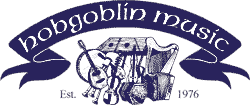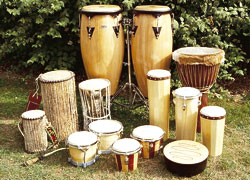
| THE HOBGOBLIN INFO SOURCE | |||
| HOBGOBLIN INDEX PAGE | HOBGOBLIN INFO INDEX | CATALOGUE CONTENTS | ONLINE DRUM SALES | |
| World Drums FAQ | ||||
 |
ON THIS PAGE: Under Construction! Djembe Background Djembe Technique Darabuka and Dumbeck Bongos Brazilian Samba Tabor Drum RELATED PAGES: Care and Maintenance |
 | ||
|
© Copyright Hobgoblin Music 1983, 2008. This text may be freely distributed in whole or in part so long as the copyright holder is clearly acknowledged. This page covers instruments we commonly see in the Hobgoblin shops Djembe BackgroundThe Djembe with its wide range of tones, produced by its thick goat skin, tight tuning and shape, is West Africa's most popular drum, originating hundreds of years ago. Today it is found throughout West Africa but it is traditionally from Senegal, Ghana, Guinea, Burkina Faso and the Ivory Coast amongst the Bambara, Mandingo, Malinka, Susu & Guru tribes. It is carved by artisans out of a solid lump of African hardwood into a goblet shape & has a goat skin which is tensioned with rope to a very high pitch. Usually several Djembe players will be accompanied by a Djun Djun player. The Djun Djun player uses one or more double headed Bass Drums & a small bell or metal tube. The troupe of drummers is lead by a "master drummer" who calls in the various sections of different patterns by playing a motif that the drummers & dancers recognize as the signal to change to the next section. The Rhythms played are usually highly Polyrhythmic to accompany the dancers highly energetic footwork. Most songs & dances are about every day life. For example hunting or bringing in a catch of fish & the dancers will act out the story. Master drummers normally come from a family of performers & are groomed for a life of music & dance from early childhood. The dances & rhythms they learn have been passed down from generation to generation often over the space of hundreds of years. Djembe TechniqueThe Djembe has three basic tones:- The Bass Tone is played with the full palm of the hand in the centre of the drum. This produces an incredibly deep resonant tone. The Closed tone (or Tone)is played with the fingers lying together on the edge of the drum producing a dull but full higher pitched sound. The Open or Slap tone is produced by letting the fingers comes apart in a relaxed way. The hand plays the edge of the drum so the fingers "stun" the drum head (throwing the fingers forward to slap the skin). This produces a loud sharp "slap" sound, which can cut through the loudest music. These three basic tones should be mastered doing simple exercises. For example: B Bass Tone; C Closed Tone; S Slap; R Right hand; L Left Hand BCC BCC BCC BCCRLR LRL RLR LRL BBS BBS BBS BBS RLR LRL RLR LRL CSS CSS CSS CSS RLR LRL RLR LRL These exercises should be practised slowly to begin with. It is important to keep relaxed throughout the whole of your body to enable you to get good tones & a nice feel. The most important thing is to get a contrast between the Slap & Closed Tone to ensure that your playing has a good "flavour". It is easy to think of other patterns based around the above examples Talking DrumAnother popular West African drum is the talking drum. This is held under the arm and played with a bent wooden stick. The pitch of the hourglass shaped drum can be changed by arm pressure on the tension strings. Darabuka and DumbeckThe darabuka is the universal drum of the Arab world, found from Morocco right across to Pakistan. Played with the fingertips, the drum is held under one arm. We get brass dumbecks (darabukas) from Pakistan, aluminium ones from Turkey and the best cast aluminium ones with vinyl covering also come from Turkey. You will find this model played by professional musicians in every Arab country. Dafeunder construction Another very popular instrument across North Africa in into Turkey is the Dafe. This is a wide shallow hand drum often with brass jingles. The sides are often ornately inlaid. There are usually available in three or more different diameters Bandirunder construction The Bandir is a north african frame drum played with the fingers. It has a wide skin with two gut snares usually. The payer tensions/tunes the back of the skin with the fingers while playing. BongosTwo small drums, one larger (and lower pitched, usually by about a fifth) than the other which are held between the knees and played with both hands. Bongo drums have been traced back to Cuba in the late 1800s, and are still largely associated with Latin music. There is some evidence to suggest that bongoes were brought to Cuba from Africa by slaves under the Spanish, and were previously used by some African tribes in religious ceremonies. Bongoes (as with other drums) are tuned by stretching the skin over the drum head. The tighter the skin the higher the pitch. In the past drums were always tuned using heat to tighten the skin, and moisture to loosen it, but these days drums with tuning mechanisms are available. It is important when tuning to make sure there is an even pressure all around the drum. Congasunder construction The congas are a tall pair of wooden framed hand drums Brazilian SambaThe instruments for carnival are very popular across the world, not just in Brazil. They comprise the Tamborim, 6" diameter tambourine usually with a fibre body, the Repinique 12"x12" aluminium shell, the Caixa Tarol 12"x 5" aluminium shell, the Caixa Malacacheta 12"x 8" aluminium shell and the bass drum, the Surdo which varies from 18" to 24" in diameter on a 24" deep rim - usually wood, but sometimes aluminium. Other Brazilian percussion instruments include: Tabor DrumTabors are the traditional English drum, ideal for accompanying Morris and other dance displays. Mediaeval drums were made with a rolled and stitched skin and rope tensioned, modern designs use a more practical wooden tension rim. We stock drums with the wooden hoop, but the mediaeval type is available to order. Small handheld tabors are used when playing a tabor pipe. Cajonunder construction Back to the Top of the Page |